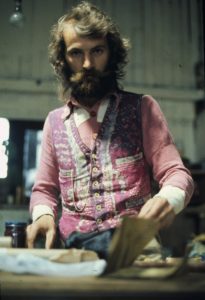

The Art of Laird Campbell
The wainscot from an old hotel, the faded water-stained and sun-blanched keel from a derelict boat, some old fencing, bits of this and that⎯found objects with texture and colour⎯all these things are and are not what they seem.
Sawn into shapes and fitted together into abstract mosaics, they take on new life as the sinuous curve of a hip that is, and is not, posed in front of a cubist backdrop of deconstructed reflections. They become totems set against a jigsaw puzzle of sky and forest. They create an angular architecture that slices shapes out of meticulously random assemblages of grained weatherworn chips of repurposed junk. An Arthur Erikson building that is not there at all is reflected in a pool that is not a pool and whose surface is not of the angled walls behind it. The hulls of overturned dories are piled like whales on a beach that merely satisfies the eyes’ need for a beach.
The profile of a face, a mask, a figure, buildings, a landscape, a table⎯all these images are so shrewdly abstracted and constructed out of such unlikely materials that their emergence, serene and innocent, creates a tension and irony that is almost metaphysical. (T.S. Eliot when writing of the poetry of John Donne described a metaphysical image as when “heterogeneous ideas are yoked by violence [intellectual vigour] together.”)
This description captures something of the art of Laird Campbell. He is an imaginative powerhouse of an artist. He is an assembler, a builder, and a maker. His palate of found objects and retextured and repurposed bits of detritus is so artfully managed and so intelligently and sensitively reimagined and crafted that his pieces are greater than the sum of their parts. His images leave the particular behind and resonate with something universal and transcendent. What more could an artist want?
Grenfell Featherstone